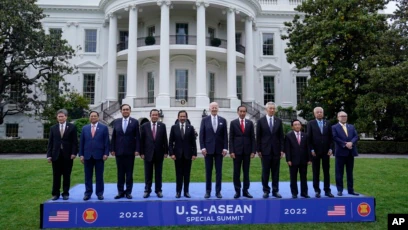
STRATEGIC ASSESSMENT. Washington DC. ASEAN leaders will finally meet US President Joseph Biden at the long-awaited US-ASEAN summit in Washington. Whether ASEAN and US can find convergence on regional issues, such as Washington’s desire to manage the rise of China, will be a pressing challenge. The leaders of ASEAN will finally meet United States President Joseph Biden in person for the first time at the White House in Washington on 12-13 May 2022. The Special Summit is much anticipated, following a series of high-level meetings between the US and ASEAN and bilateral visits to Southeast Asia by senior US officials last year.
The timing cannot be more apt, given intensifying Sino-US rivalry and geopolitical flux stemming from Russia’s recent invasion of Ukraine. There is much at stake in the Indo-Pacific, including an intensifying US-China rivalry and myriad of regional challenges such as the war in Ukraine, developments in the South China Sea, and North Korea’s recent provocations.
It is also likely that the brewing political crisis in Myanmar will be high on the agenda. Apart from calling on ASEAN to take a harsher stance on Russia, the US may take the opportunity to lobby Indonesia as the Chair of G20, Thailand as the Chair of APEC, and Cambodia as the Chair of the East Asia Summit to exclude Russia from the multilateral summits in November.
These issues will certainly be reflected in the Joint Vision Statement expected to be released following the summit. Given ASEAN’s history with tendentious issues, however, one would expect the statement to employ the usual shibboleths, ranging from the importance of the 1982 UNCLOS in the South China Sea to urging Myanmar to implement ASEAN’s Five-Point Consensus.
Eight Southeast Asian leaders descend on Washington for a special summit hosted by President Joe Biden. They represent most of the Association of Southeast Asian Nations (ASEAN), a diverse grouping ranging from the city state of Singapore to the sprawling archipelago of Indonesia.
Taken together, ASEAN’s 10 countries boast a population of over 680 million — more than Latin America, the Middle East, or the European Union — forming the fifth largest economy in the world with a GDP of $3.2 trillion.
In recent years, Southeast Asia has become a focal point of strategic rivalry between China and the United States. Alongside aggressive efforts to enforce its territorial claims in the South China Sea, Beijing is increasingly achieving its strategic goals through economic statecraft.
Its signature Belt and Road Initiative (BRI), focusing on infrastructure, and new regional trade agreements like the Regional Comprehensive Economic Partnership (RCEP) are expected to accelerate intra-Asian integration around China.
Gadjah Mada Institute of International Studies Director Riza Noer Arfani said the summit indicated that the United States could not let go of its “dependence” on ASEAN, especially in the context of regional stability. Riza said Indonesia must make sure that the United States and its allies are present at the G20 Summit in November, despite the ongoing conflict between Ukraine and Russia.
On defense, Riza said the Indo-Pacific concept, which was initiated by the Obama administration in 2008, is designed to counteract the strong influence of China, and it has become an important item to be discussed by the United States and ASEAN. Foreign Affairs Ministry Director General of American and European Affairs I Gede Ngurah Swajaya said it is important for Indonesia to ask all parties to comply with the international law when it comes to the South China Sea.
He also said the United States and its allies’ boycotting Russia at the G20 was not impossible to overcome, since Foreign Affairs Minister Retno Marsudi has dialogued with various parties, giving optimism that the G20 Summit will run well.
From the U.S. perspective, embracing ASEAN is important to contain China and isolate Russia. Senior Southeast Asia researcher at the U.S. Institute of Peace Brian Harding said the meeting showed the United States really wanted to deepen its ties with ASEAN.
ASEAN’s relations with China will overshadow the meeting, as China’s growing influence in the region is inevitable. Harding warned that Washington should not expect ASEAN to drive away from China and move closer to the United States. ASEAN will continue to maintain a balanced relationship with both. Meanwhile, Washington has not presented ASEAN with a concrete economic plan.
In hindsight, perhaps ASEAN was too optimistic about the Biden presidency. Who could blame them? After four years of the Trump administration, the region was more than ready to return to deeper engagement with the United States. A survey of regional elites showed that confidence that the United States would increase its engagement jumped from 9.9 per cent in 2020 under Trump to 68.6 per cent under Biden. That optimism has dissipated amid COVID-19, the Myanmar crisis, the Ukraine war, supply chain disruptions, fears of stagflation and increasing food and energy insecurity.
This is the context in which eight ASEAN leaders, with the exception of Myanmar’s Min Aung Hlaing and the Philippines’ Rodrigo Duterte, will meet President Joe Biden in a US–ASEAN Summit this week. This will only be ASEAN’s second in-person special summit with the United States since 2017 — and a symbolically important one, because its leaders met with Xi Jinping last year in a special 30th commemorative summit of ASEAN–China relations. ASEAN countries’ divergent positions on Ukraine and Russia, Myanmar and the South China Sea (and by extension, China’s behaviour) will make for challenging conversations with their US host.
U.S.-ASEAN Summit offers Washington the chance to make its long-discussed “pivot to Asia” a reality, especially as the bloc — with its combined population of 667 million and an aggregate gross domestic product of $3 trillion — is set to become the world’s fourth-largest economy by 2030.
Washington and its allies often mention their desire for a “free and open Indo-Pacific,” but for all the talk, the essence of this strategy — namely a strong trade and investment framework between the U.S. and the Association of Southeast Asian Nations — has yet to fully materialize.
While the reality is, of course, more nuanced, China’s growing influence in Southeast Asia rests on the fact that it appears to support, rather than dictate, the economic aspirations of developing countries in the region. U.S. military and security cooperation with Indonesia and other ASEAN countries is greatly valued, but there are so many more opportunities that can be unlocked.
Indonesia’s government under President Jokowi has proven itself to be one of the most business-friendly in the region. Jakarta is not seeking handouts, however. It wants investment and opportunities. Trade and investment need to be front and center of any discussions in the U.S.-ASEAN cooperation because as things stand, Washington’s much-vaunted “Indo-Pacific Economic Framework” remains poorly understood. Engagement must also be constant and consistent. The U.S. cannot expect to get ahead in ASEAN, or anywhere else for that matter, if it is absent from regional and international forums.
Threats to boycott November’s G20 summit in Bali amid the war in Ukraine are unhelpful, as this body should not be turned into yet another battleground for great power rivalry. As head of B20 Indonesia, I strongly believe that U.S. support for Ukraine does not, and should not, preclude it from fully participating in the G20 — or from ramping up its engagement with Indonesia and ASEAN.





